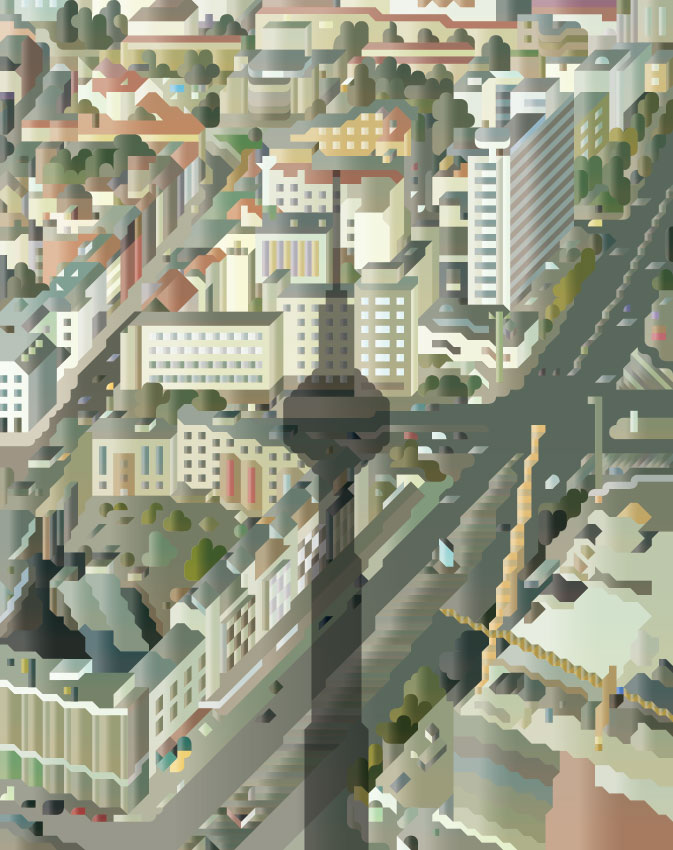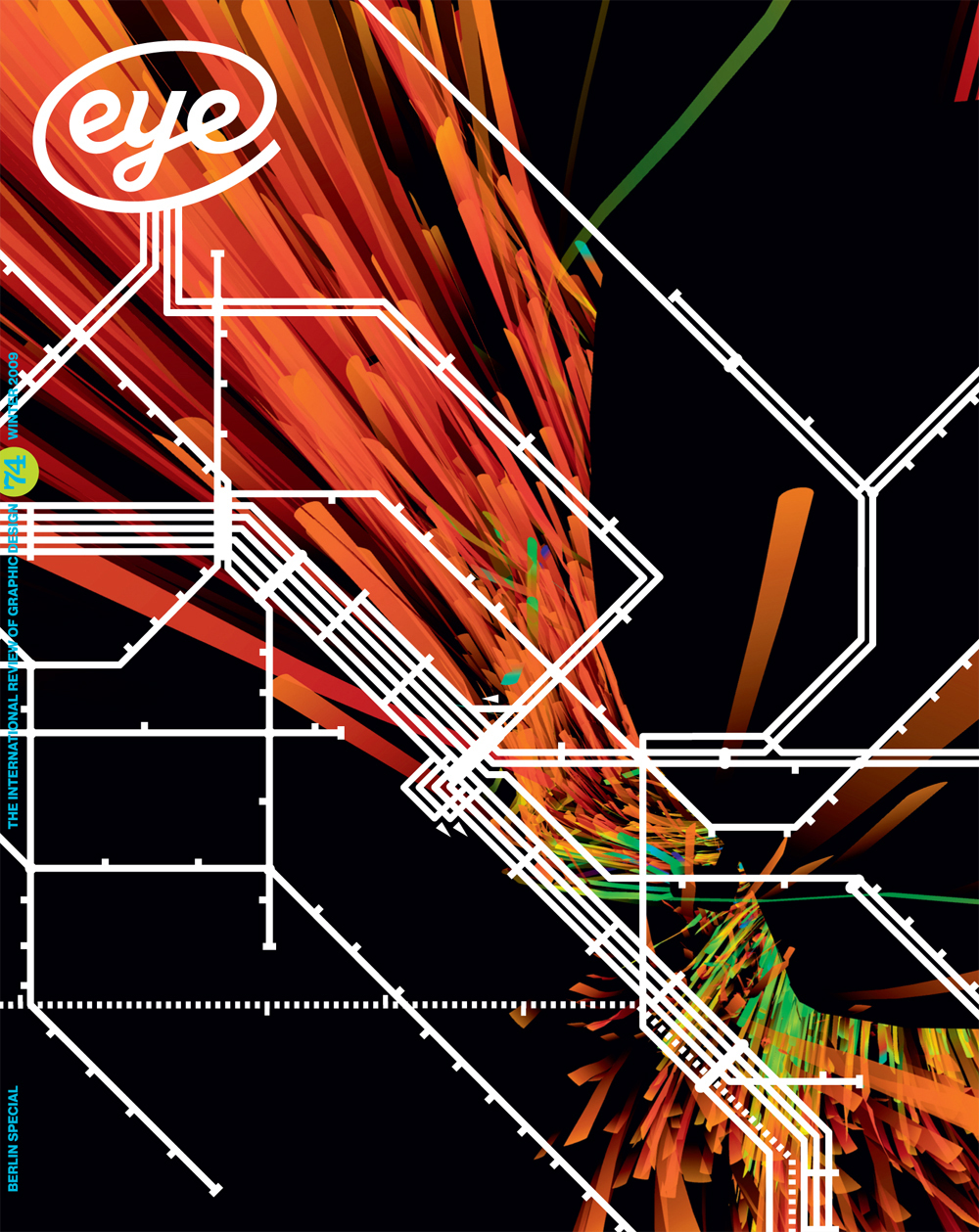Winter 2009
Berlin
It’s a state of mind, a club scene, and one of the great political, cultural and historical events of the past twenty years. Of the century. And it is full of designers – with plenty to say. For this special issue, Eye visits Berlin to explore the graphic output of this sprawling, labyrinthine and endlessly fascinating city

When someone invites me to say something about Berlin, I am often inclined to say: ‘Not yet! Give me another two months! I need to find out a little more!’ Two months later, I will probably have met a few new people and discovered a few new places, and I will be able to add more nuance to my description of what Berlin is like. I will still feel unable, though, to say anything meaningful about what Berlin actually IS.
All big cities are labyrinths, seemingly haphazard collections of people and things that the visitor or inhabitant must make sense of by drawing mental maps and simplifying multitude into essence. But Berlin seems to resist such sense-making. It is more onion-like than any other city I know: you peel off layer after layer without ever arriving at a core. The essence is in the whole, and the whole is endlessly fragmented.
Berlin is a sprawling city: with almost 3.5 million inhabitants (Paris: 2.15 million), it occupies 900 square kilometres (Paris: 105), and a quarter of this is parks, forests and water. Like London, Paris or New York, Berlin has its districts, and each has its particular culture. There are worlds of difference between the posh / bohemian atmosphere in Charlottenburg and the punk / anarchic / streetwise mood in Friedrichshain.
What makes Berlin different is that each of these places is lived and worked in by such a broad social spectrum of people. There are hardly any neighbourhoods reserved for ‘the rich’, and ghettos are few and not nearly as grim as those elsewhere in Europe. This topographic democracy has led to a remarkable freedom of choice. When looking for a home, you first decide where you want to live, then start searching. Which, in turn, has resulted in a kind of cultural segregation. It’s not your income or ethnic group that decides where you live, it’s your mindset; and once you have decided where you belong, there aren’t many reasons to get out much. Each district is more or less self-supporting when it comes to offering places to shop, see shows or rent an office. And although one of these districts is called ‘Mitte’, each part of the town is in fact its own centre.
Arm, aber sexy
Berlin attracts ‘creatives’ in all disciplines from across the world. Part of its attraction goes back to the cold war decades, when West Berlin (an island in the socialist GDR) became a refuge for young leftists, as men living here could not be drafted. It is also Europe’s most affordable big city, and its club life is the stuff of legend. Those are just a few of the reasons the city is home to tens of thousands of artists, architects, cooks, musicians, illustrators, dancers, ceramicists and fashion designers as well as product, graphic, Web, interface and type designers.
Like the physical cityscape (still under feverish development twenty years after reunification), the creative networks are in constant flux. Each organises its own events, using anything from state-owned museums and theatres to derelict office buildings or abandoned riverside plots, and catering to its own little niche. For those who haven’t decided which niche they want to be in, there is a choice of about half a dozen professionally organised festivals and conventions to go to each week.
Not that anyone has the time or money to go anywhere. When you’re young, independent and ‘creative’, you are also likely to be underpaid. It’s simple market economics. With so much talent around, studios and media production companies can afford to offer freshly graduated professionals a full-time ‘internship’, paying them something like €200 a month – and many accept, in order to collect valuable points on their curriculum, working in bars after hours or turning to their parents for support. The market position of more experienced professionals suffers accordingly. One word that often pops up in discussions about the state of the trade is SELBSTAUSBEUTUNG [self-exploitation].
There are also the ‘Digital Bohemians’ (to borrow a term coined by Sascha Lobo and Holm Friebe), busy challenging our notions of words such as professional and amateur, work and leisure (see Eye Education, pp.94-95).
Yet everybody wants to be here, and there are so many reasons to. Even if it’s not humanly possible to take advantage of even ten per cent of the potentially interesting events and places the city has to offer, it’s great to know that they’re there, and that you are welcome to add your own initiatives to the pile (and will have little trouble finding an affordable venue). It was Berlin’s mayor himself, the openly gay Klaus Wowereit, who coined the brilliant anti-slogan that sums it all up: ‘Berlin is poor but sexy’ (‘Arm, aber sexy’).
Work-life balance
Having read my notes so far, fellow Berliner and Eye writer Jessica Jenkins said: ‘That’s all very well, Jan, but there’s a contradiction. If people are so poor and have no time, which is probably true, then how come the bars are all full? Who are those designer-type people who hang out in cafés during the day?
‘Perhaps,’ she suggests, ‘it’s due to the fact that people are much more out than in, even in the evenings, rather than doing up their homes and gardens and watching TV.’
Less family life, then? But hey, in Prenzlauer Berg – designer district par excellence – the streets are now lined with designer buggies, and it seems the main product currently created there is babies. Buggies are now even beginning to show up in Friedrichshain, where the next generation of ‘creatives’ went because it was cheaper there ...
So, how does it all add up? How do life and work really relate? I should ask people in different neighbourhoods, do a survey, have someone do some nicely laid-out infographics (the Germans are very good at that), find out if there’s a pattern or something. Just give me another two months.
Jan Middendorp, designer, writer and author of Dutch Type, Berlin
First published in Eye no. 74 vol. 19 2010
Eye is the world’s most beautiful and collectable graphic design journal, published for professional designers, students and anyone interested in critical, informed writing about graphic design and visual culture. It is available from all good design bookshops and online at the Eye shop, where you can buy subscriptions and single issues.

